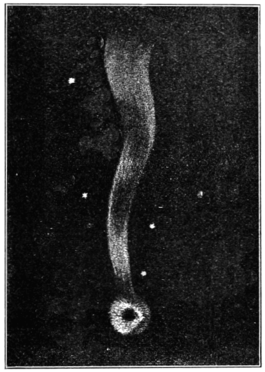sun's corona. At the appearance of the 1882 member, it was fully believed by some prominent astronomers to be the same comet which had appeared in 1843, which  Halley's Comet in the Year 1682. was being rapidly drawn into the sun by the resistance encountered at perihelion passage. It appeared, however, that the orbit, derived exclusively from observations after that event, indicated a period of six hundred or seven hundred years, at least thus disposing of the question of identity. The behavior of the body itself was, however, very suggestive as to the true condition of things. After the close approach to the sun with its tremendous tidal strain, the nucleus was found to be broken up into a number of pieces. These parts, instead of approaching each other, separated more and more as long as the body could be kept in sight. At the next return, after some six hundred or seven hundred years, there will, no doubt, be four or five separate comets, following each other at intervals of perhaps a number of years.
Halley's Comet in the Year 1682. was being rapidly drawn into the sun by the resistance encountered at perihelion passage. It appeared, however, that the orbit, derived exclusively from observations after that event, indicated a period of six hundred or seven hundred years, at least thus disposing of the question of identity. The behavior of the body itself was, however, very suggestive as to the true condition of things. After the close approach to the sun with its tremendous tidal strain, the nucleus was found to be broken up into a number of pieces. These parts, instead of approaching each other, separated more and more as long as the body could be kept in sight. At the next return, after some six hundred or seven hundred years, there will, no doubt, be four or five separate comets, following each other at intervals of perhaps a number of years.
 Halley's Comet in the Year 1759.
Halley's Comet in the Year 1759.
Halley confidently predicted the return of his comet in 1759. He also identified it as having been seen in 1305, 1380 and 1456. The difference of period, which amounted to one year and three months, was somewhat disturbing, but Halley assigned this to the true cause, namely, the perturbations produced by Jupiter and Saturn. He remarked that the period of the planet Saturn might vary as much as a month from the action of Jupiter. He says:

